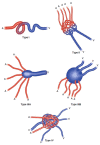Congenital Vascular Malformations in Children: From Historical Perspective to a Multidisciplinary Approach in the Modern Era-A Comprehensive Review
- PMID: 38790562
- PMCID: PMC11119901
- DOI: 10.3390/children11050567
Congenital Vascular Malformations in Children: From Historical Perspective to a Multidisciplinary Approach in the Modern Era-A Comprehensive Review
Abstract
Congenital vascular malformations (CVMs) are the result of an aberrant development during embryogenesis. Although these lesions are present at birth, they are not always visible yet. Once symptomatic, patients suffer from pain, bleeding, ulcers, infections or lymphatic leakage, depending on the subtype of vessels involved. Treatment includes conservative management, surgery, sclerotherapy, embolization and pharmacological therapy. The clinical presentation varies widely and treatment can be challenging due to the rarity of the disease and potential difficulties of treatment. This review gives an overview of the historical developments in diagnosis and classification and exposes the key elements of innovations in the past decades on the identification of genetic mutations and personalized treatment. These advances in the field and a multidisciplinary approach are highly valuable in the optimization of clinical care aimed at both curing or stabilizing the CVM and pursuing physical and psychosocial wellbeing.
Keywords: arteriovenous malformations; congenital vascular malformations; health-related quality of life; lymphatic malformations; pediatric surgery; sclerotherapy; sirolimus; venous malformations.
Conflict of interest statement
The authors declare no conflict of interest.
Figures



References
-
- Tasnádi G. Epidemiology and etiology of congenital vascular malformations. Semin. Vasc. Surg. 1993;6:200–203. - PubMed
-
- Mulliken J.B., Burrows P.E., Fishman S.J. Mulliken and Young’s Vascular Anomalies: Hemangiomas and Malformations. Oxford University Press; Oxford, UK: 2013. Classification of vascular anomalies; pp. 22–27.
Publication types
LinkOut - more resources
Full Text Sources
Miscellaneous

